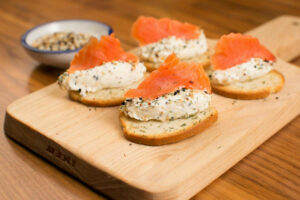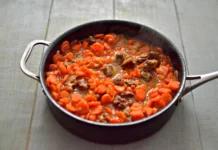
Ethel G. Hofman
It’s the American Jewish classic that goes way beyond Sunday-morning breakfasts with the whole mishpacha. Lox and bagels with a schmear of cream cheese have become a universal staple for breakfast, brunch or even as a take-along snack. Who can resist?
It’s available everywhere. There’s no need anymore for a stop at the local deli or a call to the caterer to buy it. Supermarkets carry fresh lox or lox packaged as smoked salmon in multiple flavors and sizes, from a few ounces to a megapack, in chunks or sliced thinly, which is ideal for a crowd.
Acme Smoked Fish Corp. (not to be confused with Acme supermarkets) is the largest producer of smoked salmon in the United States. A privately held, family-owned company, Acme has facilities throughout America, as well as international locations in Chile and Denmark. According to Ellen Lee-Allen, senior marketing manager of Brooklyn’s Acme Smoked Fish, the best quality fish used may be sourced from all over the world — wild from Alaska, farmed from Norway, Chile and elsewhere.
Lox wasn’t always the silky, buttery-cured salmon found nearly everywhere today.
For Eastern European Jews, it was herring salted to last through the winter. Many think of lox as a Jewish staple, but the preparation has its origins in Scandinavia. The traditional curing method was using a salty brine, not smoking the fish. It was only in the early 1900s when Jews immigrated to the United States and found salmon cheaper than herring, that lox (from the Yiddish laks) became popular.
Fish is considered pareve (foods that are neither meat nor dairy), and so for new immigrants, salmon could be bought from a nonkosher market. But what really popularized lox throughout America was the Transcontinental Railroad, which transported salted salmon from the Pacific coast to other parts of the country, including New York.
Lox and smoked salmon are often used interchangeably, but they’re not the same.
Lox or gravlax is the Scandinavian method of preparing salmon. It is preserved by covering it with a salt mixture or brined in salt water for several days. Then it can be thinly sliced and appears translucent with a mild fish flavor. It is never smoked. As in the recipe below, fresh dill added to the dry salt mixture is what sets it apart in flavor. And preparing at home, you can’t beat the price.

Nova is cured in a milder brine and then cold-smoked, which happens over an 18-hour stretch at between 70 and 75 degrees Fahrenheit. It’s less salty with a mild smoky flavor. During World War II, when salmon was hard to get, it was brought in from Nova Scotia — and the name Nova stuck. These days, smoked salmon is available flavored with seasonings such as pastrami spices and, for the nonpurist, Toragashi-flavored with a Japanese 7-spice.
Scottish-style is double-smoked for a more intense flavor. Then, of course, there’s kippered and baked salmon, usually packaged in four-ounce portions. Smokehouse temperatures stay between 150 and 160 degrees Fahrenheit — low enough to preserve the salmon’s moist texture and high enough to produce a tender flakiness.
Besides lox on a bagel, the delicate fish has helped transform nonkosher dishes into kosher delicacies. Take eggs Benedict, which became wildly popular in New York in the 1930s. Kosher-keeping Jews couldn’t eat the ham, so smoked salmon was substituted into the dish and so cream cheese was switched for the hollandaise — and presto, eggs Benjamin became a tasty kosher version.
For the bread, instead of English muffins, I use leftover toasted challah. The simple hollandaise sauce recipe below may be made pareve or dairy.
Sima’s Gravlax | Pareve
Makes 10-12 servings
Cook’s tips:
*Pull out any bones with tweezers.
*As a weight, use a 5-pound bag of sugar or flour wrapped in a plastic bag.
*May be refrigerated, wrapped tightly, for up to a week or frozen. Remove from freezer to fridge 24 hours before needed.
1½ pounds salmon fillet, boneless
¾ cup kosher salt
¼ cup sugar
1 bunch of fresh dill
Rinse the salmon in cold water. Pat it dry with paper towels. Set it aside.
In a small bowl, combine the salt and sugar. Mix well. Set it aside.
In a 3-quart casserole or shallow dish, spread one-half of the dill. Sprinkle it with one-half of the salt mixture.
Place the salmon, skin-side down, in the casserole. Cover it with the remaining dill and salt mixture. Press it firmly into the salmon’s surface.
Wrap the salmon tightly with parchment paper, then plastic wrap. Weigh down the salmon in a casserole with a 5-pound weight. Refrigerate it for two days, turning once.
Unwrap the fish and run it under cold water to thoroughly remove the dill and salt mixture. Pat it dry.
With a sharp knife, slice the salmon paper-thin on the diagonal.
It’s ready to serve with bagels and cream cheese.
Eggs Benjamin | Pareve
Serves 2
Cook’s tips:
*Substitute toasted crumpets or English muffins for challah.
*Spread thinly with cream cheese before topping with remaining ingredients.
*For hollandaise sauce, the butter or margarine must be very hot, or the mixture will not emulsify.
2 slices toasted challah, about ¾-inch thick
2-3 slices (about 2 ounces) smoked salmon
2 thin slices of sweet onion
2 slices tomato, about ¼-inch thick
2 poached or fried eggs, cooked as you like it
2 teaspoons capers (optional)
Snipped parsley or paprika to garnish (optional)
Hollandaise sauce (recipe below)
Place the challah on a serving dish. Top each slice with smoked salmon, then onion, then tomato, capers and a poached or fried egg.
Spoon a dollop of hollandaise sauce over the top.
Garnish and serve immediately.
Hollandaise Sauce | Pareve or Dairy
2 egg yolks
2 teaspoons freshly squeezed lemon juice
½ teaspoon Dijon-style mustard
Pinch each salt and white pepper
¼ cup hot butter or margarine
Place the egg yolks, lemon juice, mustard and salt and pepper in the blender jar. Whirl for 5 seconds.
With the motor running, slowly pour in the hot melted margarine or butter.
The mixture will have thickened. Use as above.
Ethel G. Hofman is a syndicated American Jewish food and travel columnist, author and culinary consultant.






